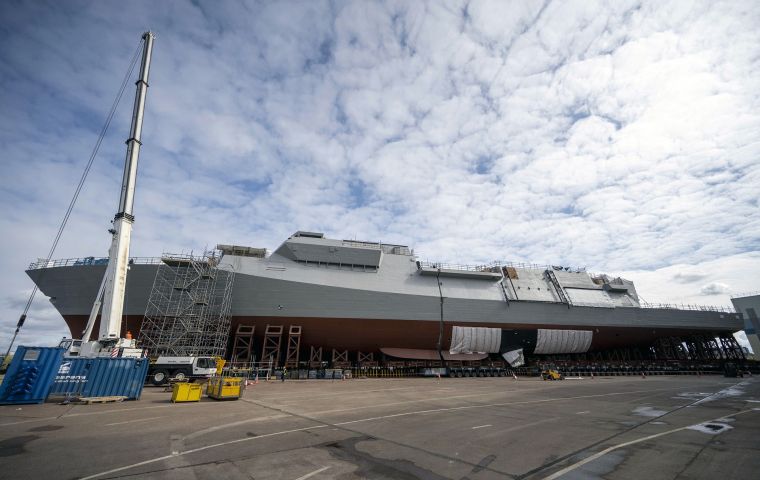MercoPress. South Atlantic News Agency
Falkland Islands' veterans get sneak peek at Navy’s formidable new frigate
 “It has been a fantastic” for these veterans who “enjoy a special link with HMS Glasgow,” explained Commander Mark Quinn with the new Type 26 HMS Glasgow.
“It has been a fantastic” for these veterans who “enjoy a special link with HMS Glasgow,” explained Commander Mark Quinn with the new Type 26 HMS Glasgow. Royal Navy sailors and arms, security, and aerospace company BAE Systems welcomed Falkland veterans to Glasgow shipyard where the first Type 26 frigate is under construction. The 44 veterans all of whom served on the previous HMS Glasgow which saw action during the Falklands visited the BAE systems shipyard on April 9th to see the new HMS Glasgow.
Many of the visiting veterans were from the HMS Glasgow Association and were joined by Rear Admiral (retired) Paul Hoddinott who commanded the HMS Glasgow during the Falklands war. Two other former commanding officers, Commodore (retired) Dick Twitchen and Commander (retired) Alistair Ireland also joined the group.
“It has been a fantastic opportunity to celebrate these veterans who enjoy a special link with HMS Glasgow,” explained Commander Mark Quinn, the Weapon Engineering Officer with the new Type 26 HMS Glasgow.
“To be able to offer them a glimpse of the next-generation Type 26 frigate and the capabilities that it will afford the Royal Navy, particularly in this 40th anniversary year of the Falklands conflict, has really made it a day to remember.”
The Falklands conflict lasted 74 days and saw seven Royal Navy ships, nine aircraft and some 225 UK military personnel lost to enemy action. Among the ships that participated was the HMS Glasgow. On May 12th, 1982, she and fellow Royal Navy vessel HMS Brilliant came under attack from Argentine Skyhawk aircraft.
The HMS Brilliant’s Sea Wolf missile system shot down the first wave of aircraft, a second saw a bomb damage the HMS Glasgow. Although it failed to explode the bomb passed through the ship’s hull disabling two of her engines and leaving a large hole.
President of the HMS Glasgow Association, Gary Easton, was a marine engineering mechanic on the ship during the attack. On May 12th he was in his usual place in the after auxiliary machinery room.
He said: “The bomb entered the ship starboard side and travelled through the engine room on the port side, holing us just above the waterline.
“I didn’t know what had happened at the time. I came to and found myself lying on the plates between two diesel generators.”
His training kicked in and Gary quickly inspected the space finding a large hole behind the port distilling plant.
“I thought – ‘I’m not supposed to see daylight and water there’,” said Gary. “It soon dawned on me the reason why!”
Gary and the crew got to work temporarily plugging the hole with pieces of timber and mattresses allowing the HMS Glasgow to stay afloat until she could sail for repairs.
Gary continued: “On behalf of myself and the HMS Glasgow Association I would like to thank the ship’s company and BAE Systems for inviting us to visit the ship.
“Special thanks go to Warrant Officer Cowey, Commander Burgess and Commander Quinn for this once in a lifetime opportunity.”
The Falklands era HMS Glasgow was a far cry from the modern warship currently under construction at the BAE Systems shipyard.
During the visit, the Association members had the opportunity to hear the next-generation capabilities that will make the new type 26 one of the most formidable frigates in the fleet.
One of those who enjoyed the tour of the shipyard, commander Ian Danbury, was an officer under training onboard the HMS Glasgow in 1982.
He said: “Forty years ago, HMS Glasgow became part of the remarkable history of the Falklands conflict and today, myself, and about 40 members of that 1982 ship’s company, are privileged to see the new Glasgow take shape at Govan.
“For all of us who sailed and fought in the old HMS Glasgow this has been a very rewarding experience.”
“The city of Glasgow is special to us for the outstanding support her people gave to the old HMS Glasgow throughout her commission and especially during the Falklands conflict.
“Visiting the new ship and her newly formed Ship’s Company has been especially poignant. We all feel that the name HMS Glasgow will be in good hands as she takes shape and joins the Fleet.”
The type 26 frigate is the first of the City Class vessels currently under construction for the Royal Navy.
Although the new HMS Glasgow’s main roles are anti-submarine warfare and air defense operations, the flexible, modular design of the Type 26s means that they can perform several roles, including maritime security, humanitarian and disaster relief, as well as counter-piracy and counter-terrorism missions.
“It is an honor to host Falkland veterans, many of whom served in the previous HMS Glasgow,” said Sir Simon Lister, BAE Systems, Naval Ships Managing Director.
“Events such as this, where we are reminded of the risks the men and women of the Royal Navy take on our behalf, strengthens our resolve to deliver the next-generation platforms and technologies that contribute to our national security and enable the Royal Navy to protect what matters most.”




Top Comments
Disclaimer & comment rulesCommenting for this story is now closed.
If you have a Facebook account, become a fan and comment on our Facebook Page!